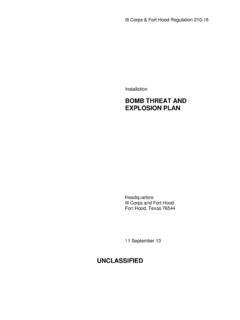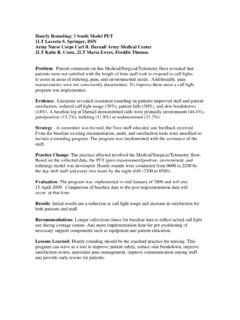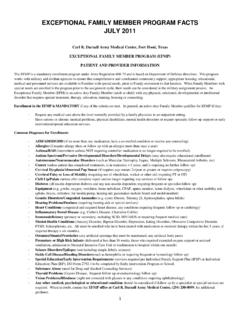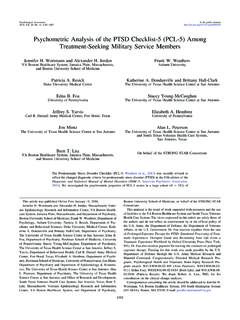Transcription of Phakic Intraocular Lens Implantation in United States ...
1 473 Journal of Refractive Surgery Vol. 27, No. 7, 2011 ORIGINAL ARTICLESP hakic Intraocular lens Implantation in United States Military Warfi ghters: A Retrospective Analysis of Early Clinical Outcomes of the Visian ICLMAJ Gregory D. Parkhurst, MD; LTC Maximilian Psolka, MD; Guy M. Kezirian, MD, FACSFrom carl R. Darnall army Medical Center, Ft Hood, authors have not received any public or private support for this study, nor do they have any proprietary interest in the products or methods mentioned herein. Presented at the Fourth Annual International Military Refractive Surgery Conference; January 11-13, 2010; San Antonio, views expressed in this article are those of the authors and do not reflect the official policy or position of the Department of the army , Department of Defense, or the US Government. Opinions, interpretations, conclusions, and recommendations herein are those of the authors and are not necessarily endorsed by the US : MAJ Gregory D.
2 Parkhurst, MD, carl R. Darnall army Medical Center, 36000 Darnall Loop, Ft Hood, TX 76544-4752. Tel: ; E-mail: June 1, 2010; Accepted: December 14, 2010 Posted online: January 17, 2011 ABSTRACTPURPOSE: To assess short-term clinical outcomes afterimplantation of Phakic Intraocular lenses (Visian ICL, STAAR Surgical Co) in US military warfi ghters who are not good candidates for laser vision correction. METHODS: A retrospective interventional consecu-tive case series analysis of all eyes that underwent ICL surgery during a 14-month time period was performed. Main outcome measures included indications for surgery, effi cacy, predictability, and early adverse events. RESULTS: Three-month postoperative visual data were available for 135 eyes of 69 patients who underwent ICL Implantation during the study period.
3 Indications included abnormal corneal topography (37%), thin pre-dicted residual bed following LASIK (32%), history of dry eye (13%), thin corneal thickness (11%), or other (7%). Mean patient age was years. Mean preoper-ative spherical equivalent refraction was diopters (D) (range: to D). Three months postoperative, uncorrected distance visual acuity of 20/20 or better was found in 129/135 (96%) eyes and 91/135 (67%) were 20/15 or better. Manifest refraction and corrected distance visual acuity (CDVA) data were available for 128 eyes. Forty-two (33%) eyes had im-provement of one or more lines of CDVA. One hundred fi fteen eyes (90%) were within D of emmetropia, and predictability within D was found in 127/128 (99%) eyes. No signifi cant intra- or postoperative com-plications were : This retrospective analysis of 3-month outcomes suggests that Visian ICL Implantation in myo-pic warfi ghters provides excellent refractive and visual results.
4 Further study is needed to evaluate long-term results. [J Refract Surg. 2011;27(7):473-481.] United States army Warfi ghter Refractive Eye Surgery Program (WRESP) was designed to reduce the limitations posed by corrective eyewear in com-bat arms soldiers. Refractive surgery is offered as an elective procedure to service members. It is authorized, but in no way mandated, by military the Fourth Annual International Military Refractive Surgery Conference, it was reported that 160 000 service members have had successful corneal refractive excimer laser surgery from several centers across the United States Department of Defense as of Prior reports of out-comes from the US army WRESP have shown excellent outcomes and improved overall battle readiness of service members with minimal complications or negative impact on military However, there remains a contingent of servicemen and women requiring corrective eyewear who are not ideal candidates for laser vision correction due to thin corneal stroma, abnormal corneal topography, or history of dry eye disease.
5 Refractive and safety results from the US Food and Drug Administration (FDA) clinical trials with the Implantable Collamer lens (Visian ICL; STAAR Surgical Co, Monrovia, California) have been This retrospec-tive study seeks to evaluate trends in patient selection crite-ria and early clinical outcomes in military warfi ghters who 474 Copyright SLACK IncorporatedPhakic IOLs in US Military Warfighters/Parkhurst et alunderwent ICL surgery at one WRESP center. To our knowledge, it is the fi rst report of myopic Phakic intra-ocular lenses (IOLs) in a military population. Although long-term follow-up may be necessary to determine the appropriate role for Phakic IOLs in warfi ghters, evalu-ation of early outcomes provides useful information about the potential for this treatment option. PATIENTS AND METHODSSTUDY DESIGN AND OUTCOMES MEASURES This report is based on a retrospective consecutive case series analysis.
6 Operative reports and clinical charts of 204 eyes of 104 patients who underwent uni-lateral or bilateral Phakic IOL surgery using the Visian ICL at carl R. Darnall army Medical Center (Ft Hood, Texas) between June 1, 2008 and July 31, 2009, were reviewed. Eyes that underwent concurrent or sequen-tial treatment for astigmatism were excluded from the study. Surgery was performed by two surgeons ( , ) using similar techniques at one center. Preoperative study metrics included indications for surgery and preoperative refractive characteristics. Intraoperative observations included the incidence of surgical complications, including laceration of the anterior lens capsule or placement of an inverted ICL. Postoperative safety measures included traumatic IOL decentration, need for IOL exchange, reports of glare and/or halos, residual refractive errors, loss of corrected distance visual acuity (CDVA), cataract formation, corneal decompensation, endophthalmitis, occlusion of iridotomy sites, and elevated Intraocular pressure (IOP).
7 Postoperative effectiveness measures included manifest refractive outcomes and uncorrected distance visual acuity (UDVA). Calculations for visual acuities were performed using logMAR Refrac-tions are reported at the spectacle plane (vertex mm) unless specifi ed otherwise. Data analysis was performed using Microsoft Excel (Microsoft Corp, Redmond, Washington). Evaluation of statistical signifi cance for continuous data was per-formed using the Student t test, and bivariate data were evaluated using chi-square tests. Signifi cance was in-terpreted at a P level of .05. When appropriate, comparisons using UDVA and refractive data were performed to determine clinical differences among cohorts. PATIENT MANAGEMENTAll refractive surgery patients in the Darnall cen-ter are required to discontinue contact lens wear for a minimum of 3 weeks prior to preoperative evaluation.
8 Refractive stability during the preceding 12 months, de-fi ned as change in manifest refractive spheroequivalent diopters [D]) and change in manifest astigmatism D, is required for all refractive surgery candi-dates. Only eyes that do not qualify for corneal excimer laser surgery are considered for ICL surgery. Patients are considered for ICL surgery if they do not have a his-tory of cataract, glaucoma, or retinal detachment. Eyes must have an anterior chamber depth of at least mm; although in some cases during this study period, ante-rior chamber depth of at least mm was considered when gonioscopy revealed a minimum Shaffer grade III angle. Laser YAG peripheral iridotomies are placed 1 to 2 weeks prior to lens Implantation ; however, two eyes of one patient in this series had surgical peripheral iri-dectomies performed at the time of IOL Implantation .
9 Preoperative measurements recorded and analyzed in this chart review included UDVA, manifest refrac-tion, determination of CDVA, computerized corneal topography, and anterior chamber depth using the Pentacam (Oculus Optikger te GmbH, Wetzlar, Ger-many). Visual acuity measurements were obtained using either a Snellen eye chart in a 20-foot eye lane or in a NIDEK Epic-5100 refractive station (NIDEK Co Ltd, Gamagori, Japan). Additional measurements in-cluded axial length and keratometry (IOLM aster model ce0297; carl Zeiss Meditec, Jena, Germany) and white-to-white measurement using Orbscan IIz (Bausch & Lomb, Rochester, New York) and a hand-held caliper. lens powers were chosen based on predicted outcomes generated by a surgical lens calculator provided by the lens manufacturer, which takes into account axial length, keratometry, manifest and cycloplegic refrac-tion, anterior chamber depth, and corneal thickness.
10 In most instances, emmetropia is targeted, but age and military occupation are also taken into account when choosing lens power, which was available in increments. Baseline endothelial cell counts were evaluated in all TECHNIQUELens Implantation technique was similar for both surgeons. A primary incision was placed on the steep axis of corneal cylinder, or temporally, based on sur-geon preference, using a keratome blade. Two percent hydroxypropyl methylcellulose (Bausch & Lomb) ophthalmic viscosurgical device (OVD) was used to protect the corneal endothelium during ICL im-plantation using the ICL cartridge and injector (STAAR Surgical Co). Automated irrigation and aspiration was used to remove the OVD following placement of the ICL into the ciliary sulcus. Acethylcholine chloride in-traocular solution 1:100 (Novartis, Stein, Switzerland) was used to constrict the pupil once the lens was con-475 Journal of Refractive Surgery Vol.









